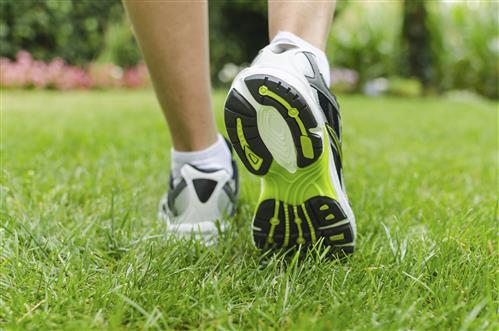Understanding Heel Pain for Runners
If you are a runner and you are having heel pain, the key to recovery is identifying the source of your pain. It may be due to one of the two most common causes, namely, Achilles tendinitis or plantar fasciitis. Is your pain toward the back of the heel, or in the area of the Achilles tendon, where it extends up to your calf muscle? Those symptoms suggest tendinitis.
Is the pain coming from underneath the heel bone or the arch of the foot? In that case, the likely source is plantar fasciitis. The plantar fascia is a thick tissue running from the heel all the way to the toes. Pain commonly is worse when first rising in the morning, and often increases over a period of months.
Whatever the source, the best advice is not to ignore it and “work through the pain,” a common tendency of athletes at every level. The likely result would be continually worsening pain and injury, requiring more aggressive treatment and longer time away from running or other favorite activities.2

Causes
Achilles tendon injuries are a leading cause of heel pain for runners. That single tendon is asked to carry as much as 12 times your body weight when running. Acute tendinitis results from inflammation of the sheath surrounding the tendon). Tendinosis describes the chronic condition resulting when runners often ignore the pain and keep running with it for months or years, causing actual degeneration of the tendon.1
Plantar fasciitis can result from repeated heavy activity, causing or aggravating multiple microtears or larger tears. These produce inflammation and pain even when performing the most normal everyday activity.2
Training errors are a major source of injuries for both conditions. Avoid injuries through correct training and overcome them with good rehabilitation.1 The Achilles is in a tough spot, receiving low blood supply while being expected to carry a major load. Starting with a healthy Achilles tendon is crucial for runners, because the more you run, the more work it is asked to perform.
Most running injuries that occur during training result from overwork, running on problematic terrain, and poor choice of footwear.
- Training: build up mileage gradually; increasing mileage too quickly or taking too many hills can lead to problems. Some doctors recommend a 10 percent rule, meaning never increase mileage by more than 10 percent from one week to the next.
- Shoes: too much cushioning without adequate support will let the foot sink too far while the calf muscle is contracting. As a result, the tendon is pulled in two directions.
- Poor terrain or soft surface: a good example is running on sand, which makes the tendon work too hard, or an uneven road which continuously stresses one side.1

Treatment
Heel injuries require immediate attention to avoid further damage. Start by understanding your injury. If you experience Achilles tendon pain, you will want to see your doctor for the best advice and treatment plan, but, for immediate treatment of mild tendinitis, apply ice, elevate, and rest the foot. Allow a few weeks of reduced running activity, to give it time to calm down and start healing.1 Your doctor or physical therapist can recommend specific strengthening and stretching exercises to help rebuild and renew flexibility in the injured tendon, once it is ready.
Cross-training is a significant aid in recovery from injury or stress to the Achilles heel. Instead of pushing through with your usual running routine, switch part of your workout to swimming and biking to maintain fitness, while giving the tendon a chance to rest and heal.
These are common recommendations that will start you on the road to recovery:
- Ice and Rest, the dreaded “R” word, hated and ignored by many runners and walkers, but a necessity to allow damaged tendons and tissues to begin healing.2 Elevate injured foot and apply an ice pack covered with a thin cloth, alternating brief periods on and off ice to reduce inflammation.
- Stretch. Keep your calf muscle stretched with a mild daily routine that repeats 4 to 10 times a day (more details below).2
- If these steps do not resolve your pain, be sure to visit your podiatrist. They may recommend one of a number of treatments, ranging from anti-inflammatories to steroid injections, a castboot, a custom-made orthotic, and finally, as a last resort, surgery.2
Prevention
Amazing fact: The calf is second only to the heart as the hardest-working muscle in the human body. It makes sense, since the calf is involved in every step you take throughout your lifetime. Keep your calf muscle healthy, as it directly connects to and is supported by the Achilles tendon.1
Daily stretching of the calf muscle is a must. Simply place your hands on the wall, extend one leg straight behind you, keep the other knee bent with foot forward, and gently stretch, then switch legs. This runner’s stretch can be performed multiple times a day in just minutes, and in almost any location, at home or at work.
Check with your doctor for advice on orthotics appropriate to your foot type, such as heel lifts that may help with Achilles tendon irritation. These kinds of adjustments can dramatically decrease stress on the tendon.1
Plantar fasciitis will benefit from many of the same preventive measures recommended for tendinitis, but take action to specifically care for that overworked part of the foot. It turns out your mother was right—always wear shoes. Doctors advise that you avoid going barefoot, which puts undue strain on the plantar fascia. Mom probably also told you to wear the right kind of shoes. Doctors say you should wear shoes that do not bend in the middle. They should only bend at the toes (just as your foot only bends at the toes).2
If you these preventive and early treatment methods don’t provide relief, explore alternative therapies with your podiatrist. Options might include taking anti-inflammatory drugs like ibuprofen, additional padding in shoes to soften the impact of walking, wearing a night splint to keep the plantar fascia extended while sleeping, or custom-made orthotic devices to wear in your shoes. Some people benefit from injections of corticosteroids to reduce stubborn pain and inflammation. Ask your doctor about physical therapy exercises to overcome recurring or persistent heel pain, and be ready to put your best foot forward every day.
Sources:













